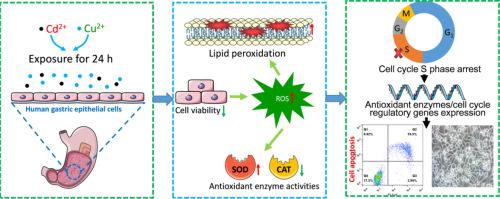Science of the Total Environment ( IF 8.2 ) Pub Date : 2020-11-23 , DOI: 10.1016/j.scitotenv.2020.143951 Kun Wang , Jiao-Yang Ma , Meng-Ying Li , Yi-Shu Qin , Xin-Chen Bao , Cheng-Chen Wang , Dao-Lei Cui , Ping Xiang , Lena Q. Ma

|
Cadmium (Cd) and copper (Cu) are widely present in foods. However, their adverse effects on human gastric epithelium are not fully understood. Here, human gastric epithelial cells (SGC-7901) were employed to study the toxicity and associated mechanisms of Cd+Cu co-exposure. Their effects on cell viability, morphology, oxidative damage, cell cycle, apoptosis, and the mRNA levels of antioxidases and cell cycle regulatory genes were investigated. Co-exposure to Cd (5 μM)/Cu (10 μM) induced >40% cell viability loss, whereas little effect on cell viability at <10 μM Cd or 40 μM Cu. Compared to individual exposure, co-exposure induced greater oxidative damage by elevating ROS (3.5 folds), malondialdehyde (2.3 folds) and expression of SOD1 and HO-1 besides inhibiting CAT, GPX1 and Nrf2. A marked S cell-cycle arrest was observed in co-exposure, evidenced by more cells staying in the S phase (36%), up-regulation of cyclins-dependent kinase (CDK4) and CDKs inhibitor (p21) and down-regulation of CDK2, CDK6 and p27. Furthermore, higher apoptosis (22%) with floated and round cells occurred in co-exposure group. Our data implicate the cytotoxicity of Cd+Cu co-exposure was higher than individual exposure, and individual assessment would underestimate their potential health risk. Oxidative stress and cell cycle arrest possibly played a role in Cd+Cu induced toxicity and apoptosis in SGC-7901 cells. Our data suggest the importance to reduce Cd in foods to decrease its adverse impacts on human digestive system.
中文翻译:

镉和铜诱导人胃上皮细胞毒性的机制:氧化应激,细胞周期停滞和凋亡
食物中广泛存在镉(Cd)和铜(Cu)。然而,它们对人胃上皮的不利影响尚未完全了解。在这里,人类胃上皮细胞(SGC-7901)被用来研究Cd + Cu共暴露的毒性和相关机制。研究了它们对细胞活力,形态,氧化损伤,细胞周期,细胞凋亡以及抗氧化酶和细胞周期调控基因mRNA水平的影响。共同暴露于Cd(5μM)/ Cu(10μM)会引起> 40%的细胞活力损失,而对<10μMCd或40μMCu的细胞活力几乎没有影响。与单独暴露相比,共同暴露通过升高ROS(3.5倍),丙二醛(2.3倍)以及SOD1和HO-1的表达,除了抑制CAT外,还引起更大的氧化损伤,GPX1和Nrf2。在共同暴露中观察到明显的S细胞周期停滞,表现为更多的细胞停留在S期(36%),细胞周期蛋白依赖性激酶(CDK4)和CDKs抑制剂(p21)的上调。CDK2,CDK6和p27。此外,共同暴露组的漂浮细胞和圆形细胞的凋亡率更高(22%)。我们的数据表明,Cd + Cu共同暴露的细胞毒性高于个人暴露,个人评估会低估其潜在的健康风险。氧化应激和细胞周期阻滞可能在Cd + Cu诱导的SGC-7901细胞毒性和细胞凋亡中起作用。我们的数据表明减少食品中Cd的重要性,以减少其对人体消化系统的不利影响。











































 京公网安备 11010802027423号
京公网安备 11010802027423号